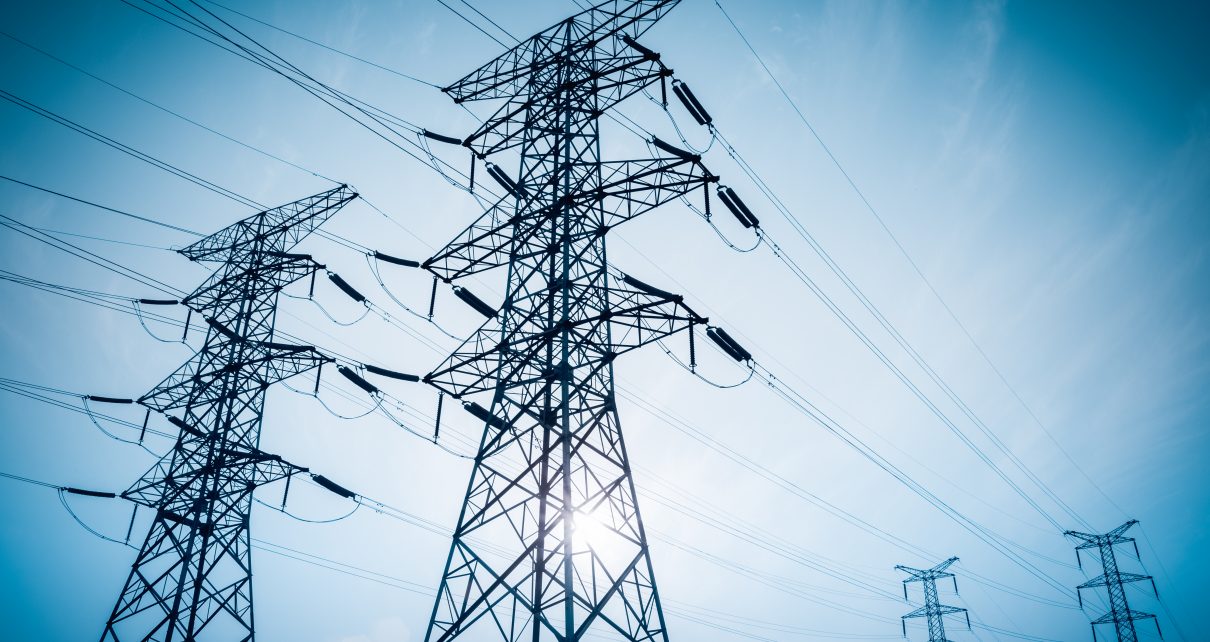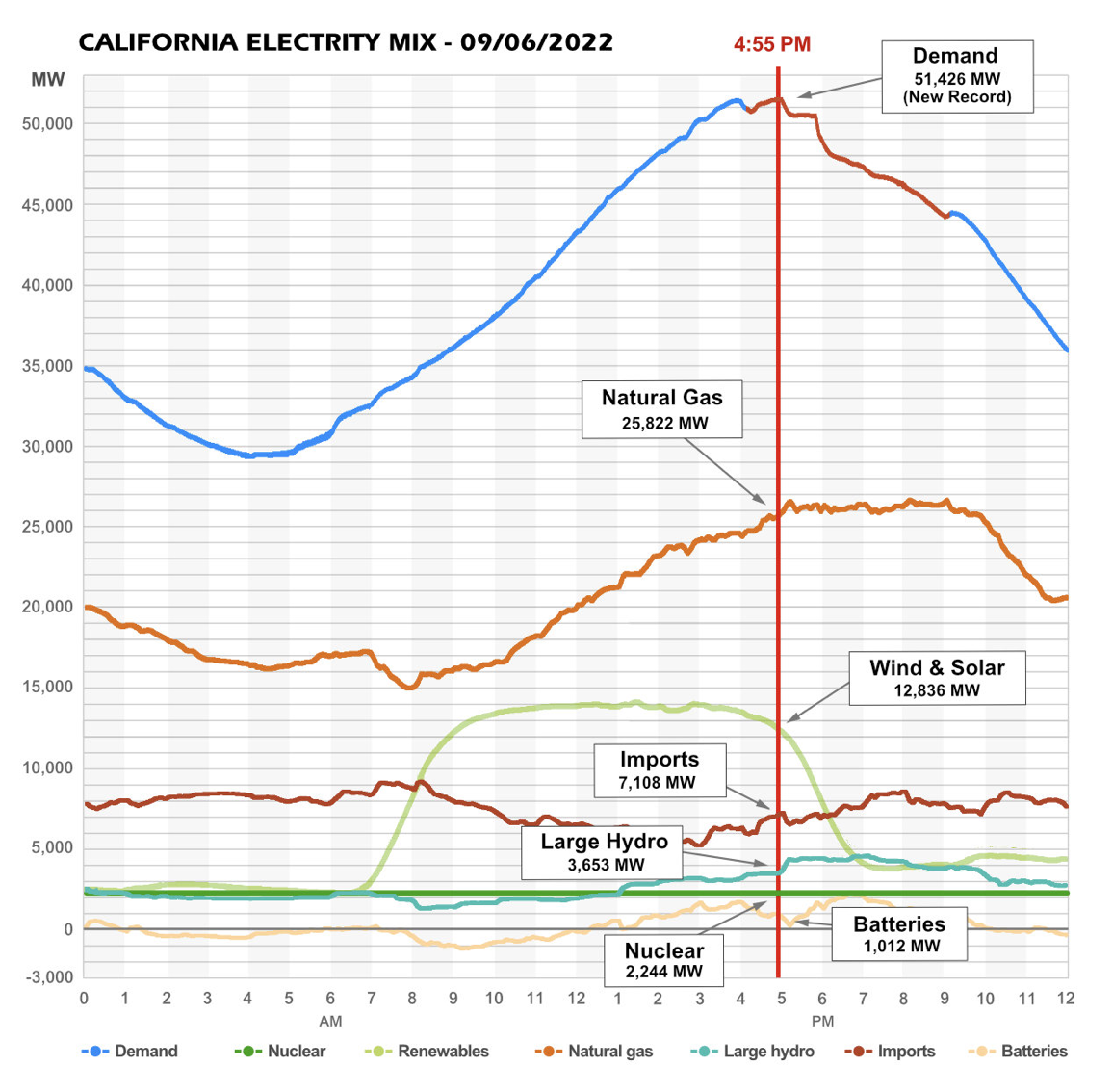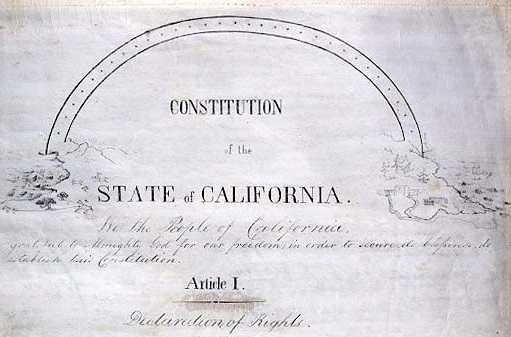
Electricity Transmission Pylon at Dusk. (Photo: chuyuss/Shutterstock)
Lessons Learned From California’s Averted Power Crisis
Dispatchable vs. Renewable Electricity: Without nuclear and gas-fired electricity, California would be left at the mercy of the sun and wind for its power
By Carl Wurtz, September 21, 2022 2:50 am
Shortly after 4:55 PM on Sept. 6, California’s electricity grid set a new record. Briefly, residents and businesses were consuming electricity at a rate of 51,426 million watts, and the grid was stretched to its limit. Were it not for consumers reducing consumption in response to an urgent plea texted to 30 million cellphones, rolling outages initiated by system operator CAISO could have spiraled into a system-wide outage, shutting down the state and all of its businesses, and putting public health in jeopardy.

On electricity grids, supply of electricity must, at all times, be adjusted to meet demand precisely – no more, no less. For determining what led to California’s near-disaster, the image above is revealing:
- The top line (blue and red) shows demand – how much electricity consumers were using during that day.
- The lines below it show the various components of supply – what sources were used to meet demand (the heights of each of these lines added together is equal to the height of the demand line at any given time).
- During peak demand, over half of California’s electricity was being supplied by natural gas-fired electricity. At that time, gas plants were releasing 11,600 tons of CO2 into the air per hour.
- One-fourth of peak demand was met by wind and solar.
- Three-fourths of CA electricity imports are generated by out-of-state gas and coal plants.
- Assistance provided by batteries was negligible (1.9%).
- Between 9AM and 4PM solar generation was curtailed (deliberately limited) to 14,000 megawatts, so that natural gas could be ramped up in time to provide missing power after the sun went down.
- California reached peak consumption nearly ½ hour after CAISO’s plea to reduce consumption was issued.
Most forms of renewable electricity, including wind and solar, are intermittent – they aren’t always available to meet demand. In contrast, dispatchable sources like natural gas, coal, and nuclear, with an abundant supply of fuel in store, may be dispatched as needed.
California’s grid mix that day shows that, without nuclear and gas-fired electricity, California would be left at the mercy of the sun and wind for its power. It shows that dispatchable electricity will always be necessary to assure grid reliability, and that without the carbon-free electricity provided by Diablo Canyon and a new generation of advanced nuclear plants, meeting our state’s ambitious climate goals will be impossible.




We also learned that in the game of chicken Newsom blinked. He has lost the heart and minds of Californians who got locked down because of his policies.
He also knows that turning off the electricity would doom his Presidential aspirations.
This was a very well written article.
Note on the graph that “batteries”, like the much touted climate-change activist PG&E/TESLA facility at Moss Landing that caught fire yesterday, is the lowest supply to the grid. We need to increase the “nuclear” supply by at least a factor of 2.
What would the solar output have been if it wasn’t purposely curtailed? “…Between 9AM and 4PM solar generation was curtailed (deliberately limited) to 14,000 megawatts, so that natural gas could be ramped up in time to provide missing power after the sun went down….” And why curtail it instead of selling it to the grid, or does no one even want it?
Good question. If there was no curtailment between 9AM and 4PM and it was a sunny day, solar generation would follow a smooth curve peaking at about 22,000 MW at 1 PM. Why wasn’t extra electricity exported to Arizona, or Nevada? Another good question. Most likely in these situations, Arizona and Nevada are experiencing the same weather we are, and don’t need it.
We can always sell it at negative prices – essentially, pay other states to take it. But sometimes it’s cheaper to pay solar farms to curtail their electricity. “We have to pay solar farms to turn off their electricity?!”, you might ask. The answer is yes – at mid-day on sunny days, California electricity customers must pay solar farms, whether they’re providing electricity or not, to prevent them from destroying our grid. And some wonder why our electcricity prices are among the highest in the U.S.!
@Jimmy: There are engineering rationales for limiting the maximum amount of solar and wind to about 14,000 megawatts that are beyond the scope of this article. Californians are already paying billions annually for curtailment of excess solar capacity in the middle of the day. We pay neighboring states to take our excess solar power while they also have abundant solar power. California also pays renewable generators to self-curtail. During a recent interview, Governor Newsom said without reliable Diablo Canyon, California would be at risk of rolling blackouts. While it is mis-transcribed, at 2:24. Governor Newsom identifies Diablo Canyon as the insurance policy near the end of this ABC-7 Los Angeles video from September 8, 2022. https://abc7.com/newsom-blackouts-grid-power/12211041/
And they want us to be 100% renewable by WHEN, again???
Once more, this article demonstrates that Newsom is issuing mandates that he can’t deliver on…
And we are being suckered by not pushing back HARD at said mandates…
Essentially, he’s ordering us to jump out of a plane with a half-sewn parachute and expecting us to finish stitching it up on the way down…
And we are gonna go SPLAT if we allow him to pursue his ill-thought policies….